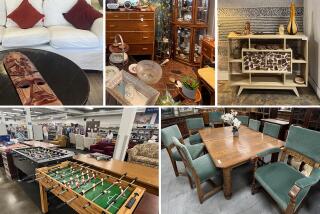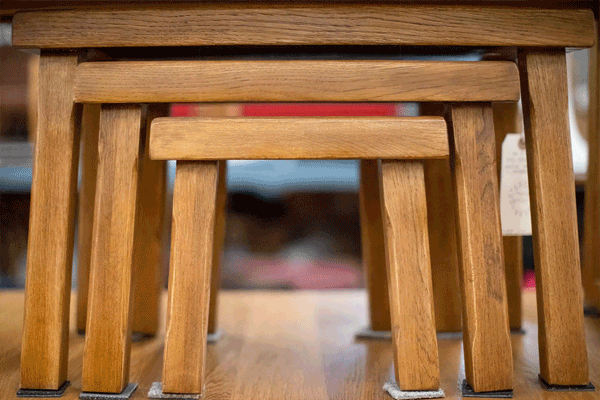Sure, you love it -- but should you buy it?
- Share via
There are few shopping thrills like the one when your eye zeroes in on that perfect Pucci dress or Stegner first edition or Eames chair -- in the middle of the retail chaos known as a thrift store. At that moment, the primitive hunter-gatherer side of the brain kicks in and it’s hard to be rational: You must buy it, broken zipper, cracked spine and wobble be damned.
But this is the time to take a deep breath and make some cold assessments: It’s not a great deal if it’s going to cost big bucks to fix, or is beyond repair. Here’s what to look for.
Clothing
Is it well made?
“It all comes down to the finishing -- it’s more about what’s on the inside than the outside,” says Katy Rodriguez, co-owner of Resurrection on Melrose, a collectible clothing boutique. “Check to see if the pockets are done well, if the buttons are leather or if the zipper is American made.” Tug on the seams to see if they are separating. If it’s a jersey or knit, look for stretches or pulls; they usually can’t be fixed.
Is there spotting or staining?
Nylon and polyester are the easiest to dry clean, Rodriguez says. Some cottons can handle light bleaching or spot bleaching. Silk is the most difficult, but “if you run your fingers across a stain on silk and it’s raised above the fabric, you might be able to get it out.” Finally, hold the garment up to the light to look for moth holes or cigarette burns. A good cleaner can reweave wool and other fabrics, but it can get expensive.
Is it smelly?
“Smoke is the hardest smell to get rid of,” Rodriguez says. “I’ve had leather pieces cleaned five times and it still won’t come out.” If there are mild body odors, a couple of trips to the dry cleaner may do the trick. You can also try washing a smelly find with a cup of white vinegar added to the detergent and water. If more drastic measures are called for, try soaking the item in vinegar and water for a few hours and then running it through the gentle cycle.
Furniture
Is it sound?
If the piece is made of wood, look for repaired breaks in the structure, and pay close attention to the legs. “If there are cracks or previously broken sections, it’s best to leave the piece behind,” says interior designer Marne Dupere -- especially if there are hairline fractures in the supports of a couch or chair. “If it’s something nonstructural like a broken or cracked finial on a rocking chair, you can easily replace that.”
Look underneath the piece. “Check to see if the chair, for example, was made with eight-way hand-tied springs; they look like coils instead of zigzags,” she says. The coils are better quality.
Sit on the piece; if the foam is very hard or very soft, it may need to be restuffed, which is expensive. Foam can rot and will get harder with age -- if you sit down and can hear or feel it crack, “it will need to be reupholstered,” she says.
Is it high quality?
A detailed foot or brass welds and accents often mean greater attention was paid to the overall construction of the piece. If the piece is metal, look at the quality of the welding. “The weld points shouldn’t look sloppy or uneven,” she says. Eye the metal itself to determine its gauge -- thicker is better.
Scrutinize the joints. “If they seem overly wobbly, it may not be a great buy,” Dupere says. “Gently rock the joints ... to see if they are loose. Some loose joints may just need a screw tightened. A cracked joint is more serious and may need professional repair.”
Pick it up. If it’s heavy, that’s good. Dense hardwoods are better quality.
Finally, look for original upholstery. The closer to original condition, the more valuable. If the material is in poor condition, keep in mind that it can cost thousands to reupholster a couch.
Records
Is it warped or scratched?
Sanders Chase, owner of the Record Collector, the 30-year-old temple to vinyl on Melrose Avenue, suggests holding the record at eye level and checking to see if its surface is even. “If it’s warped, don’t buy it.” The same goes for scratches: Pull the record out of its sleeve and inspect both sides for lines or marks.
Is it flimsy?
The thicker the record, the better the sound quality. A simple test: Hold two editions of the same record in each hand. The heavier one is invariably the earlier edition and, depending on the quality of the vinyl, the more valuable.
Is it a first pressing?
The first pressing -- the lot of records produced from the original master recording -- has the best sound. A first pressing can be determined by consulting reference books such as “The Music Lover’s Guide to Record Collecting” by Dave Thompson.
Books
Is it falling apart?
If you’re simply looking for a fun paperback to read, the only concern you have is legibility; if you want a showpiece on your shelf, condition is everything, says William Dailey of Dailey Rare Books in West Hollywood.
Check the spine (“A split or crack can be reglued by a professional binder,” Dailey says) and dust jacket (it shouldn’t be ripped. If it’s missing, the book is worth less).
Note the overall condition. “If the binding is leather and is split, it can be ... repaired,” he says. Flip through the pages, looking for folds, rips or writing. Ink cannot be removed.
Is it a first edition?
They are worth more. Since half the publishers don’t list a book’s edition in its pages, Dailey suggests consulting a rare-book guide or bibliography. A good place to start is “Hooked on Books: Everybody’s Guide to Book Collecting” by Maurice Dunbar.






